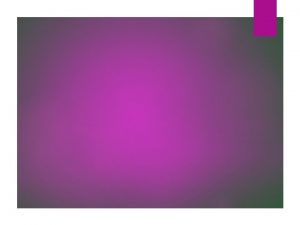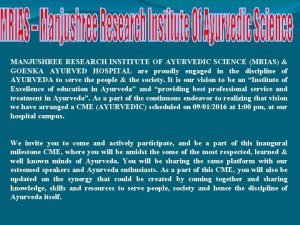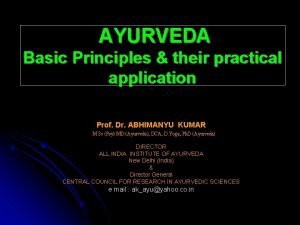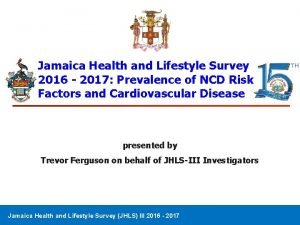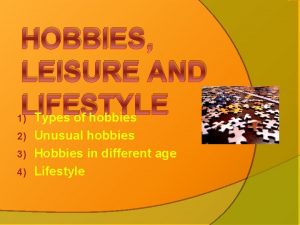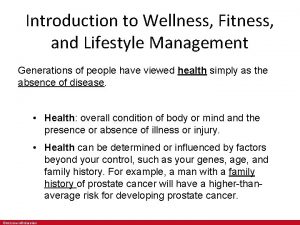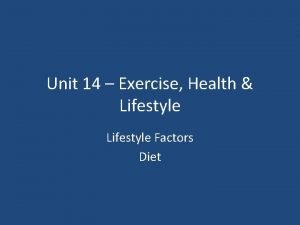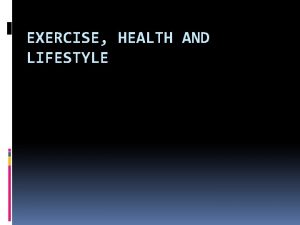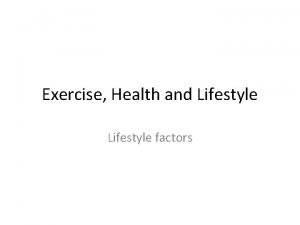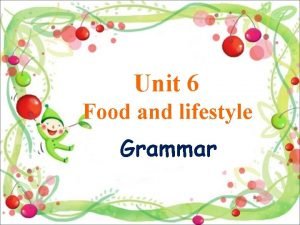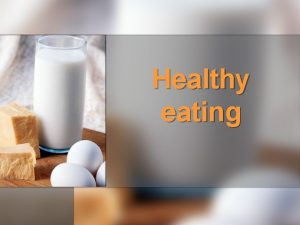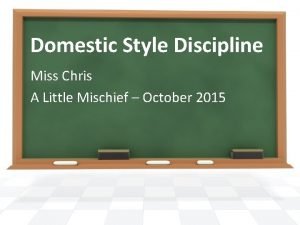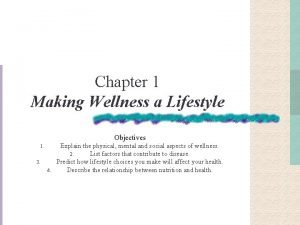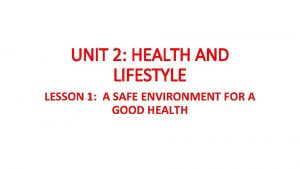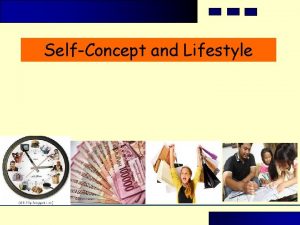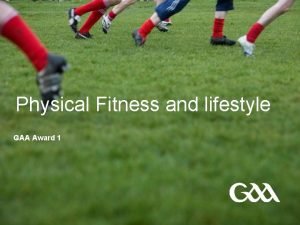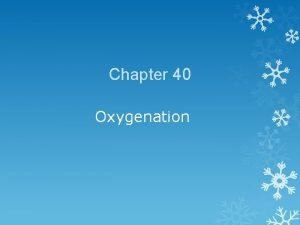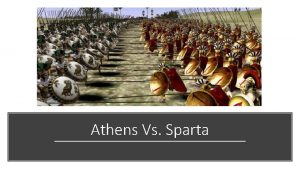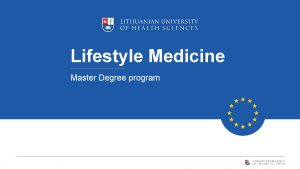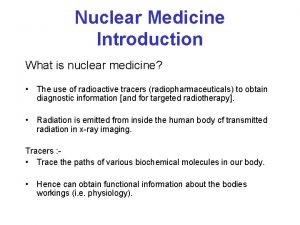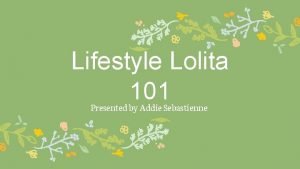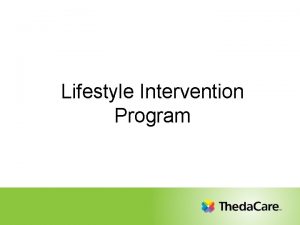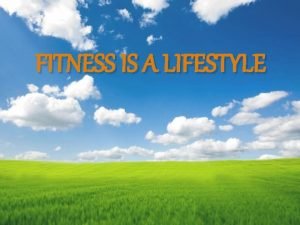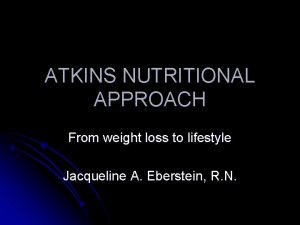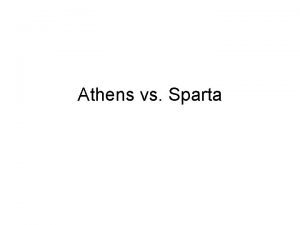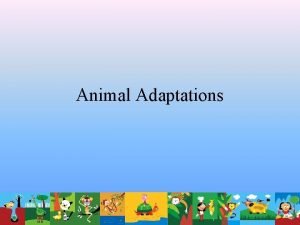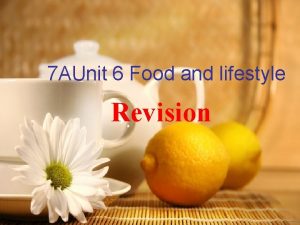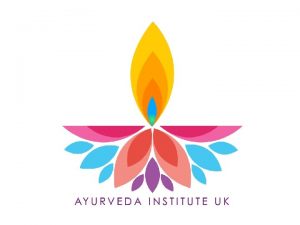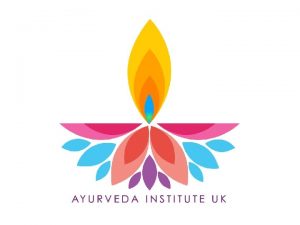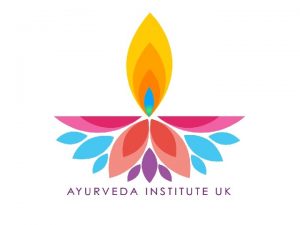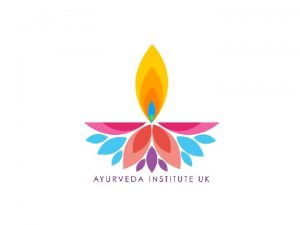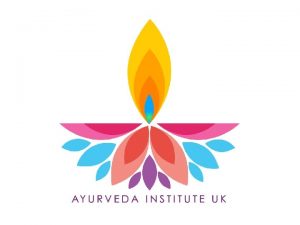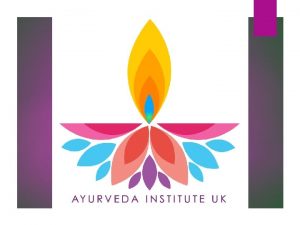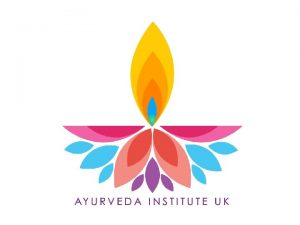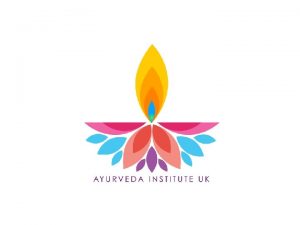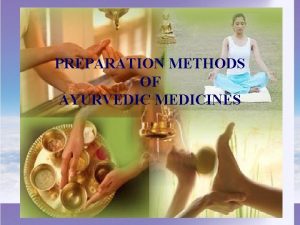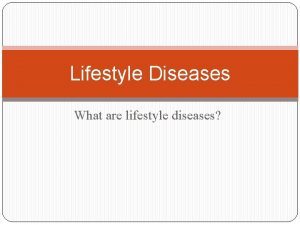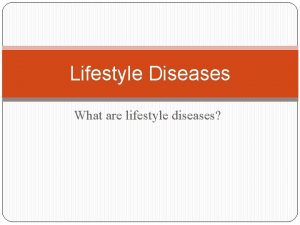DIPLOMA in Ayurvedic Lifestyle and Nutrition 27 th


























































- Slides: 58


DIPLOMA in Ayurvedic Lifestyle and Nutrition 27 th & 28 th April 2019 Module 8 2

CHIKITSA Ayurvedic Methods of Treatment

“Tath kriya viyadi narshini” “Any action can arrest the progress of the disorder”

Chikitsa consists of: 1. Swathsa Parayana = prevention of disorders (90%) 1. Athura Parayana = cure of disorders(10%)

Chikithsa (treatment system in Ayurveda) Shamana (pacifying) External Shastra (surgery) Ksharakarma (cauterize with alkali) Agni karma (cauterize with fire) Lepa (poultices) Shodhana (purifying) Internal External Internal Agnidipana Sneha Pana Amapachana Abhyanga Kshuth Shirodhara Thrut Swedana (steam Vyayama bath and pinda- Atapa Avagahana maruta Vajikarana (aphrodisiac) Rasayana (rejuvenating) Male , female infertility Impotency and libido Vamana (ematic) Virechana (purgation) Nasya (nasal Swastha parayana Maintain & prevention of health Ahara (dietary advice & nutrition)) 1. Sathmya (pathyawholesome) 2. Asathmya (apathyaunwholesome) Vihara (lifestyle advice & counselling) Kayika – uthkshepana, apakshepana vachikayoga, mantra, sthotra, music irrigation) Vasti (enema) Raktamokshna (blood letting) Oushadha (medicines) Upashaya (therapeutic trials) Anupashaya (same qualities alleviate the disorder)

Shamana (pacifying) External • Shastra (surgery) • Ksharakarma (cauterize with alkali, kshara sutramedicated threads) • Agni karma (cauterize with fire) • Lepa (poultices) Internal • • Agnidipana (digestants) Amapachana (carmanatives) Kshuth (fasting from foods) Thrut (fasting from liquids) Vyayama (physical exercises) Atapa (exposure to sun light) Maruta (exposure to wind)

Shamana Chikitsa • Shamana Chikitsa or palliative therapy is a curative therapy • Can either alleviate the symptoms of the disease or eliminate or dilute the effect of Ama • By stimulating pathways and opening channels for detoxification and stimulating the digestive fire • External and internal forms of treatment

External methods (localised treatment to eliminate or dilute Ama: • Shastra (surgery) • Kshara Karma (substances or herbs to cauterise) • Agni Karma (application of heat with herbs or fire e. g. moxibustion in TCM) • Lepa (application of herbal preparations, such as poultices)

Internal methods of treatment: • Agni deepana (balancing the digestive fire) • Ama pachana (elimination of superficial toxins) • Ksuth (fasting from food – langana) • Thruth (fasting from water – langana) • Atapa (exposure to the sun or sun bathing) • Maruta (exposure to air or breathing practices - pranayama) • Viyayama (exercise such as yoga)

Shodhana (purificatory) External Sneha Pana (ingestion of oil) Abhyanga (application of oil to the body) Shirodhara (pouring medicated oil in a continuous stream onto the third eye chakra) Swedana (steam bath and fomenting treatment with pinda rice and herbal poultices) Avagahana (herbal oil bath) Internal • Vamana (ematic) • Virechana (purgation) • Nasya (nasal irrigation) • Vasti (enema) • Raktamokshna (blood letting)

Shodana Chikitsa • Panchakarma or detoxification is a part of purification therapy • By use of the most immediate pathway for complete elimination of toxins from the body • external and internal methods of purification

Importance of purifying treatments “dosha kadachith kupyanti jita langhanapachanaih Ye tu shodhanaih shuddha n tesham punarudbhavah” When ever the doshas are aggravated, they can be subsided by langhana (fasting) & pachana (digestives). After purifying doshas, the disease can eradicate without recurrences

External methods of purification; Purva Karma (preparatory treatment for the Panchakarma): • Sneha Pana (ingestion of oil) • Abhyanga (application of oil to the body) • Shirodhara (pouring medicated oil in a continuous stream onto the third eye chakra) • Swedana (steam bath and permenting treatment with pinder - rice and herbal poultices) • Avagahana (herbal oil bath)

Internal methods of purification; Pradhana Karma (5 main methods to eliminate root causes of diseases): • • • Vamana (emetic treatment) Vasti (enema) Virechana (purgative) Nasya (nasal irrigation) Rakta Mokshana (blood letting)

Rasayana Chikitsa Rasa (plasma) + ayana (path to enhance) = nourishment of dhatu Rejuvenation therapy Slows down ageing process Delays the degenerative processes in the body Rasayana = special herbs, fruits and medications to promote health and longevity • Provides maximum nourishment to the Dhatus and boosts Ojas. • •

Types of Rasayana Chikitsa 1. Kutipraveshika (cave therapy & oil bath) • Strict measures and diet, under expert guidance • Carried out in a specially built hutwith no wind and light • Person should free of any major illness • Age group 25 to 70 years • Duration- two months to four months

2. Vatatapika (oil bath and herbal treatments) • Less rigorous and places less restriction on diet • Prescribed for individuals who find it difficult to follow a strict diet, and for people who are weak with some illness • The medicines will be decided by the physician based on the condition of patient’s health.

Some herbs/ foods with rasayana property • Dates, mung beans – increase tissue and organ strength • Long pepper, garlic –respiratory, tissue strength, increase digestion, digest toxins • Haritaki – eliminates waste products , boosts digestion • Gotukola, vacha – increase intellect & memory • Guggulu –further digestion of waste products • Amlaki – decreases catabolic process & postpones ageing • Bhallataka –powerful immune promoting substance • Punarnava – promotes kidney functions • Shatavari –infertility, increases libido, deals with menopause, promotes lactation

Vajikarana Chikitsa • Increases libido in both sexes • Improves the functions of the reproductive organs • Vitalises reproductive tissues • Increases semen count and sperm motility • Makes eggs more viable for conception • Balances the Soma and Surya (masculine and feminine) in order to attract each other

Used as treatment for: Male • Sexual dysfunctions • Infertility • Premature Ejaculation and Erectile dysfunction Female • Infertility • Low libido

Some herbs with vajikarana property • Ashwagandha (Withania somnifera) – reduce stress levels, increase circulation, increase energy, boost immunity, reduce inflammation, increase nerve functions • Shatawari (Asperagus racemosus) – increases libido, helps deal with menopause, promotes lactation in lactating mothers, increase quality and quantity of semen • Kapikachchhu (Mucuna pruriens) – stress reducing, strengthen nervous system • Sugar cane – instant body energizer, increase quality and quantity of semen • Vidari (Pueraria tuberosa) – increase body strength, boost immunity, increase quality and quantity of semen

Swastha parayana Maintain & prevention of health Oushadha Ahara (dietary Vihara (lifestyle advice & nutrition) advice & counselling) 1. Sathmya (pathya- 1. Kayika – 1. Upashaya uthkshepana, apakshe (therapeutic trials ) pana, yoga, exercises 2. Anupashaya 2. vachika- (same qualities (apathya- mantra, sthotra, unwholesome) alleviate the music disorder) wholesome) 2. Asathmya (medicines)

Swathsa Parayana The maintenance of wellbeing + the prevention of disorders through: • Ahara (dietary advice and nutrition) • Viherana (lifestyle advice and counselling) • Oushada (remedies, seasonal adjustments and constitution)

Ahara (dietary advice and nutrition) • Ahara = diet/nutrition • Understanding the medicinal value of food, i. e. food as medicine • Food alone can be a complete therapy • Capable of curing disease or arresting the disorder itself

Viharana (lifestyle advice & counselling) i. Kayika • • Ukthshapana (to uplift) Akshapana (to bring down) ii. Vachika Yoga (not just asana) Mantra Strostra (Bajan, music, singing) Prayer Vastu shastra (the Indian ‘science of architecture’ influencing town planning, architecture, ergonomics, feng shui) • Thithi (astrology) • • •

Oushada (remedies) i. Upashaya • using remedies with opposite qualities to alleviate disorders ii. Anupashaya • using remedies with the same qualities to alleviate disorders

Chakra

Chakra - wheels of energy • Wheels of energy • Chakra form an energy system in the human body • There are 7 chakra • Responsible for total health; sense of mental, physical, emotional, and spiritual well-being • Junctions of consciousness (mind) and physical body

• Nourish particular organs and control various psychophysiological pathways • Transport neuro-electrical and spiritual energies of the spinal cord • Responsible for conveying stimuli from the higher centres (eg brain, pituitary gland) to the lower organs

• Correlates to the endocrine system • Chakra imbalance presents as problems with endocrine system • Eg. Pituitary gland, thyroid, ovaries etc

Endocrine glands

Chakra imbalances • Flow of energy is obstructed by: – deep buried memories within the subconscious mind from childhood trauma – tension build up at chakras which can affect posture, metabolism, breathing and emotional state • Physical ailments can develop by chronically repeated blockage of pranic energy • Chakra massage opens and cleans these energy pathways

Seven chakras 1. Muladhara chakra 2. Swadhishthana chakra 3. Manipura chakra 4. Anahatha chakra 5. Vishuddha chakra 6. Ajna chakra 7. Sahasra chakra


Muladhara chakra / root chakra • The root centre • Base of the spinal column • Correlates to the network of nerves supplying electrical impulse/energy to the region of the external genitals • Relates to endocrine gland – eg. testes • Primordial element - Earth • Chakra of our basic needs ie food, water, air • The center where we ground ourselves • Sex energy

When imbalanced… • Problems in the legs, feet, rectum, tailbone, immune system • Male reproductive parts and prostrate gland • Degenerative arthritis, knee pain, sciatica • Eating disorders, constipation. • Emotional imbalances include feelings affecting basic survival needs: money, shelter and food

When balanced… - We feel - supported - sense of connection - safe in the physical world - grounded - healthy body awareness

Swadhishthana chakra/ sacral chakra • Sex centre • 2 inches below naval • Related endocrine glands - ovaries and adrenal • Primordial element - water • Chakra of procreation

When imbalanced… • Physical imbalances - sexual and reproductive issues - urinary problems, kidney dysfunctions - hip, pelvic and low back pain • Emotional imbalances - inability to commit to relationships - failure to express emotions - fears of impotence, betrayal - addictions

When balanced… We feel - able to take risks - creative - committed - passionate - sexually confident - outgoing

Manipura chakra/ solar plexus chakra • The navel centre • Situated at umbilicus • Closely associated with the coelic or solar plexus • Primordial element – fire • Related endocrine gland - pancreas

When imbalanced. . . • Physical imbalances - digestive problems, liver dysfunction, stomach ulcers - chronic fatigue - high blood pressure - diabetes - pancreas and gallbladder issues - colon diseases • Emotional imbalances - issues of personal power and self-esteem - fears of rejection, criticism - anxiety about physical appearances

When balanced… We feel - greater self-respect - self-compassion - in control - assertive & confident

Anahatha chakra / heart chakra • Heart region • Related endocrine gland - thymus • Primordial element - air • Between the lower three and the higher three chakra • It is the chakra of devotion, love and trust • There is a connecting pathway from heart to throat chakra

When imbalanced… • Physical imbalances - asthma, lung disease - heart disease - issues with breasts eg. cysts, cancer - issues in lymphatic system - upper back and shoulder problems, arm and wrist pain • Emotional imbalances - issues of the heart - loving to the point of suffocation - jealousy, abandonment, anger, bitterness - fear of loneliness

When balanced… We feel - joy - gratitude - love and compassion - forgiveness flows freely - greater trust

Vishuddha chakra / throat chakra • Throat region • Related to endocrine gland - thyroid and parathyroid • Primordial element - space • Chakra of communication, the inner meets with the outer • Poor expression and communication can block chakra • By opening the chakra, one feels love and connection to self and others and it helps in improving creativity to thrive.

When imbalanced. . . • Physical imbalances - thyroid issues, sore throats, laryngitis - disorders related to the jaw & mastication - ear infections, ulcers - facial problems (chin, cheek, lips, tongue problems) - neck and shoulder pain • Emotional imbalances - poor self-expression both spoken or written - fear of powerlessness or lack of choice - no willpower or being out of control

When balanced… We experience - a free flow of words, expression & communication - honesty and truthfulness & steadiness - ability to listen and give attention

Ajna chakra / third eye chakra • Between the eyebrows - “third eye” centre • Related to the hypothalamus & limbic system • Endocrine gland - pituitary gland. • Ida, Pingala, and Sushumna meet (trikuta – 3 roads joining, the place to meditate) • Alpha (individual soul) meets with omega (higher self) • Center of imagination, intuition perception and balance

When imbalanced… • Physical imbalances – headaches, sinus issues - blurred vision, eyestrain - seizures - hearing loss - hormone function • Emotional imbalances - mood swings, volatility - inability to look at one’s own fears - inability to learn from others - day-dream / live in a world with exaggerated imagination

When balanced… We feel – strong intuition – a connection to oneself and mentally fit – clear & focused – able to distinguish truth from illusion – open to receive wisdom and insight

Sahashra chakra / crown chakra • Brain centre • Described in yogic texts as having a thousand one petals • Sahasrara is the area of the pineal gland • Secretes a very superfine essence of tarpaka kapha called soma

When imbalanced… • Physical imbalance – depression, migraine type headache - inability to learn - sensitivity to light, sound, environment - extreme fatigue • Emotional imbalances - issues with self-knowledge and greater power - Imbalances arise from rigid thoughts on religion and spirituality - constant confusion - carry prejudices - fear of alienation - insomnia

When balanced… We feel - able to live in the present moment - an unshakeable trust in our inner guidance

Chakras and marmas Name Plexus and glands Ayurvedic marma Muladhara Sacral, coccygeal plexus, testes Guda Svadhishthana Hypogastric, lumbar plexus, Kukundara ovaries and adrenals Manipura Solar, coeliac plexus, pancrease Nabhi and bruhati Anahata Cardia plexus. Thymus Hridaya Vishuddha Cervical, carotid, pulmonary plexus Nila, manya Thyroid, parathyroid Ajnya Cavernous plexus, optic chiasma, Sthapani thalamus Sahasrara Brain Adhipathi

The interrelation of the chakras When one chakra is blocked, the other chakras begin to compensate and either become overactive or under-active
 Diploma in modern dietetics and ayurvedic nutrition
Diploma in modern dietetics and ayurvedic nutrition Manjushree ayurvedic college
Manjushree ayurvedic college Ayurvedic theory
Ayurvedic theory Modern lifestyle and hypokinetic diseases
Modern lifestyle and hypokinetic diseases Jamaica health and lifestyle survey
Jamaica health and lifestyle survey Hobbies leisure and lifestyle
Hobbies leisure and lifestyle What is fashion logistics
What is fashion logistics Reaching wellness through lifestyle management
Reaching wellness through lifestyle management Wellness and lifestyle management
Wellness and lifestyle management Attempts to develop quantitative measures of lifestyle
Attempts to develop quantitative measures of lifestyle Exercise health and lifestyle
Exercise health and lifestyle Spartan hierarchy
Spartan hierarchy Exercise health and lifestyle
Exercise health and lifestyle Exercise health and lifestyle
Exercise health and lifestyle Hobbies and leisure time
Hobbies and leisure time Healthy lifestyle wrap up lecture
Healthy lifestyle wrap up lecture Four tomatoes
Four tomatoes Healthy eating sentences
Healthy eating sentences Lathalain halimbawa
Lathalain halimbawa Domestic discipline lifestyle
Domestic discipline lifestyle Chapter 1 making wellness a lifestyle
Chapter 1 making wellness a lifestyle Why do geographers call arabia a crossroads location
Why do geographers call arabia a crossroads location Unit 2 lifestyle
Unit 2 lifestyle Lifestyle dimensions
Lifestyle dimensions Gaa lifestyle
Gaa lifestyle Seventh day adventist church
Seventh day adventist church Peran keluarga kristen dalam gaya hidup modern
Peran keluarga kristen dalam gaya hidup modern Healthy lifestyle moodboard
Healthy lifestyle moodboard Unit 2 lifestyle
Unit 2 lifestyle Tim too many young people are
Tim too many young people are Planning gaa
Planning gaa Gaa lifestyle
Gaa lifestyle Lifestyle reporting
Lifestyle reporting Acrostic of life
Acrostic of life Active lifestyle definition
Active lifestyle definition Lifestyle performance profile
Lifestyle performance profile Embracing a healthy lifestyle
Embracing a healthy lifestyle Factors that affect oxygenation
Factors that affect oxygenation Athens vs sparta differences
Athens vs sparta differences Negative effects of industrial revolution
Negative effects of industrial revolution Lifestyle medicine degree
Lifestyle medicine degree Now lifestyle autoresponder
Now lifestyle autoresponder Lifestyle
Lifestyle Spatial resolution
Spatial resolution Lifestyle entrepreneur characteristics
Lifestyle entrepreneur characteristics 101 lolitas
101 lolitas Thedacare lifestyle intervention program
Thedacare lifestyle intervention program Fitness is a lifestyle
Fitness is a lifestyle For adult
For adult Endocrinologist lifestyle
Endocrinologist lifestyle Food related lifestyle model
Food related lifestyle model Firstbeat lifestyle assessment
Firstbeat lifestyle assessment Atkins lifestyle
Atkins lifestyle Performance lifestyle advisor
Performance lifestyle advisor Athens and sparta differences
Athens and sparta differences Behavioral adaptations of zebras
Behavioral adaptations of zebras Lifestyle countable or uncountable
Lifestyle countable or uncountable Diploma in funeral arranging and administration
Diploma in funeral arranging and administration Diploma in funeral arranging and administration
Diploma in funeral arranging and administration
